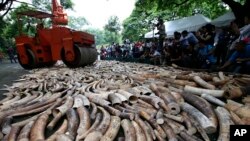The sweeping grasslands of the African savannah might not exist without elephants. They knock down so many trees that forests transform into plains, where other grazers and birds feed. Elephants maintain the shape of the land, and without them, everything would change. And for many, that would make the world a poorer place.
“There’s some connection between humans and elephants that would be a really sad thing to lose,” says Kevin Uno of Lamont-Doherty Earth Observatory at Columbia University.
Uno warns that elephant extinction is a possibility this century, as poaching of African elephants is at an all-time high. There are only about 400,000 left in the wild, and 30,000 are killed each year for their tusks. “In a span of 15 to 20 years, we could lose our elephants,” the researcher said.
Elephant ivory is highly sought-after as a carving material, especially in China and Japan. Trade in ivory was made illegal in 1989 under the Convention on International Trade in Endangered Species (CITES). Ivory that was harvested before the ban, however, is still legal to buy and sell. This is a perplexing issue for anti-poaching efforts: how to tell the old, legal ivory from the new, illegal ivory?
An international team of scientists, including Dr. Uno, determined that the answer can be found with a test measuring the level of radioactive carbon in a piece of ivory.
Atmospheric radiocarbon has been at an especially high level since nuclear weapons testing by the United States and Soviet Union in the 1950s. The radioactive element has been degrading ever since. By matching the amount of radiocarbon in a tusk with the amount in the atmosphere at a given time, the researchers can tell when the tusk grew - and when the elephant was killed.
The team's findings were published in the Proceedings of the National Academy of Sciences. The researchers say they hope the test will allow investigators to distinguish legally-sold ivory from before the trade ban, from illegal ivory that was poached more recently. This will presumably enable more effective enforcement of the ban on ivory trading, and disruption of poaching.
The technique can also be used to date horns and tusks from other animals, including rhinoceroses, which are at even worse risk of extinction due to poaching.
Kevin Uno says that enforcing the trade ban is only part of the battle to save elephants. The ivory trade is completely driven by the demand for ivory, and he advocates efforts to educate buyers about the consequences of their actions.
“What we need to send,” said Uno, “is a very clear message that when you buy something that’s made of ivory, there’s an elephant that died for that.”
The Obama administration has announced an executive order to combat the illegal sale of endangered animals in Africa. The order provides $10 million to benefit anti-poaching efforts throughout sub-Saharan Africa.
“There’s some connection between humans and elephants that would be a really sad thing to lose,” says Kevin Uno of Lamont-Doherty Earth Observatory at Columbia University.
Uno warns that elephant extinction is a possibility this century, as poaching of African elephants is at an all-time high. There are only about 400,000 left in the wild, and 30,000 are killed each year for their tusks. “In a span of 15 to 20 years, we could lose our elephants,” the researcher said.
Elephant ivory is highly sought-after as a carving material, especially in China and Japan. Trade in ivory was made illegal in 1989 under the Convention on International Trade in Endangered Species (CITES). Ivory that was harvested before the ban, however, is still legal to buy and sell. This is a perplexing issue for anti-poaching efforts: how to tell the old, legal ivory from the new, illegal ivory?
An international team of scientists, including Dr. Uno, determined that the answer can be found with a test measuring the level of radioactive carbon in a piece of ivory.
Atmospheric radiocarbon has been at an especially high level since nuclear weapons testing by the United States and Soviet Union in the 1950s. The radioactive element has been degrading ever since. By matching the amount of radiocarbon in a tusk with the amount in the atmosphere at a given time, the researchers can tell when the tusk grew - and when the elephant was killed.
The team's findings were published in the Proceedings of the National Academy of Sciences. The researchers say they hope the test will allow investigators to distinguish legally-sold ivory from before the trade ban, from illegal ivory that was poached more recently. This will presumably enable more effective enforcement of the ban on ivory trading, and disruption of poaching.
The technique can also be used to date horns and tusks from other animals, including rhinoceroses, which are at even worse risk of extinction due to poaching.
Kevin Uno says that enforcing the trade ban is only part of the battle to save elephants. The ivory trade is completely driven by the demand for ivory, and he advocates efforts to educate buyers about the consequences of their actions.
“What we need to send,” said Uno, “is a very clear message that when you buy something that’s made of ivory, there’s an elephant that died for that.”
The Obama administration has announced an executive order to combat the illegal sale of endangered animals in Africa. The order provides $10 million to benefit anti-poaching efforts throughout sub-Saharan Africa.
